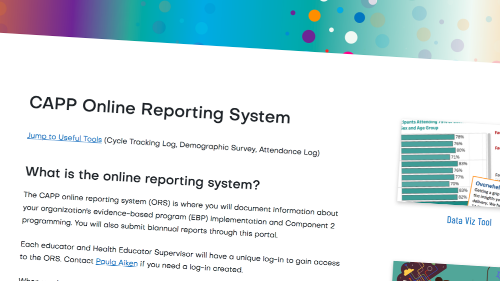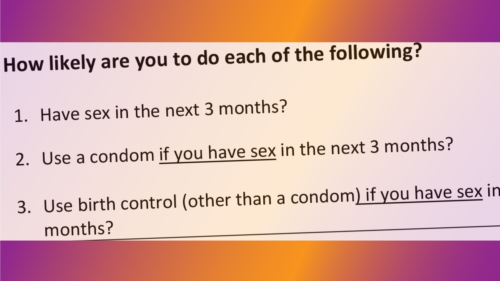CAPP: Be Proud! Be Responsible!
Be Proud! Be Responsible!: A Safer Sex Approach to HIV Prevention (BPBR) was developed to reach high school students in a school or community-based environment. BPBR is designed to help adolescents develop the knowledge, skills, and motivation necessary to change their behaviors in ways that will reduce their risk of contracting HIV and other sexually transmitted infections. To change behavior, adolescents need not only information and a perception of personal vulnerability, but also the skills and the confidence in their ability to act safely. To support youth in preventing unplanned pregnancies, an add-on module provides an overview of birth control methods. BPBR aims to reinforce self-confidence and pride by using a sense-of-community approach and encouraging sexual responsibility.
Evidence of Effectiveness
In rigorous research studies conducted in 1998 and 2005 BPBR was shown to significantly impact condom use, frequency of unprotected sex, number of sexual partners, and STI rates in the desired direction. More recent studies have shown either no effect or mixed results.
Curriculum Summary and Objectives
CAPP providers should use the 5th edition of BPBR, available for purchase from ETR.
At the end of this program students will:
- Have increased their knowledge about pregnancy, STIs, and HIV/AIDS
- Believe in the value of safer sex, including abstinence
- Have confidence in their ability to negotiate safer sex and to use condoms correctly
- Be able to use condoms and negotiate sexual situations
- Intend to practice safer sex
- Reduce sexual risk behaviors
- Take pride in and responsibility for choosing responsible sexual behaviors
Implementing BPBR
Be Proud! Be Responsible! is comprised of a series of fun and interactive learning experiences designed to increase participation and enhance learning. Activities include educational videos, trigger films, role plays, condom demonstrations, and other exercises. Most activities are brief, lasting no more than 20 minutes.
Successful implementation of evidence-based programs requires significant planning. Use the template below to create your implementation plan.
Implementation guidelines make clear the program developer's recommendations as well adaptations you may need to consider. Take these guidelines into account as you plan for implementation.

Important Reminders
Pre-Post Surveys
Remember, pre-post surveys are required for each evidence-based program you implement. Learn more:
Educator Training
Prior to facilitating the program, educators must complete the Training of Educators for BPBR and the online implementation training offered by ACT for Youth. Scheduled trainings are posted on the CAPP Training Calendar:
Documentation
All adaptations — planned and unplanned — must be recorded in the online reporting system.
Adaptations
While some adaptations will render a program ineffective (for example, turning a skill-building activity into a lecture), others are necessary (updating language to make a program more inclusive of specific populations, for example). Whenever possible, necessary adaptations should be planned in advance, working with ACT for Youth.
To help you plan, implement, and report adaptations systematically, ACT for Youth has developed planning tools for master lists of adaptations for each EBP. Health Educator Supervisors can use these tools to draft a master list. Your ACT for Youth Support Team will work with you to finalize the list.
See additional resources below for adaptations that may be appropriate for your settings and populations.
Additional Resources
Marketing BPBR to Schools: Alignment with NYS Health Education Standards
Evidence-based programs can be aligned with New York State health education standards at many points. By learning the language of New York State schools and understanding how your program maps onto health education standards, you will be able to explain how your services can help schools meet their goals. The alignment grid below shows the points of connection between BPBR and NYS health education standards.
Preparation: Sample MOU Template and Opt-Out Letter
To clarify roles and expectations, it is helpful to have a signed memorandum of understanding (MOU) between an implementation site and your project. Implementation sites may also appreciate a sample parent notification letter and opt-out form.
Preparation: Supplies/Equipment Checklist
This checklist serves as a reminder of what educators need to bring on site to facilitate each module.
On Site: Adaptation Notes Tool
When adaptations happen on the fly, they must be recorded. All data on adaptations can help us understand how to improve program implementation. To facilitate note-taking, the document below has a notes section for each activity.
On Site: BPBR Posters
Posters provided in the BPBR program kit are small and hard to read. ACT for Youth has created color slides of each poster. These slides can be downloaded and enlarged.
Adaptation: Alternative Videos
ETR recommends these alternative videos as a green-light adaptation to ensure content is medically accurate, up to date, and inclusive.
Adaptation: Adjust BPBR for Spanish Speakers
Planned Parenthood of Nassau County created PowerPoint slides in Spanish to facilitate implementation of BPBR (2016) to predominantly Spanish-speaking audiences. The slides include instructions for activities, key words, and posters. PPNC also revised and translated the Myth or Fact activity.
Adaptation: Gender Inclusive Language
This sample master list suggests ways to use language to be inclusive of all gender identities.
Adaptation: Intellectual and Developmental Disabilities
The purpose of this guide is to assist educators who are implementing BPBR with participants who have developmental or intellectual disabilities.
Adaptation: PrEP and PEP
This document suggests adaptations to include information about PrEP and PEP HIV prevention medications.





